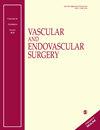Clinical Efficiency and Safety of Radiofrequency Ablation for Treating Incompetent Great Saphenous Veins in Aged Patients
IF 0.7
4区 医学
Q4 PERIPHERAL VASCULAR DISEASE
引用次数: 0
Abstract
IntroductionFew studies have focused on the safety and efficacy of radiofrequency ablation (RFA) in treating incompetent great saphenous vein (GSV) in aged population. This study was designed to investigate the clinical efficacy of RFA in treating incompetent GSV in the aged patients.MethodsIn this retrospective study, we included 138 consecutive patients (involving 194 limbs) with a mean age of 63.0 years who underwent RFA and microphlebectomy or sclerotherapy due to symptomatic incompetent GSV with saphenofemoral junction reflux. Based on their ages, patients were classified into young group and aged group. Then we compared the preoperative and postoperative Clinical, Etiology, Anatomic, Pathophysiology (CEAP) classification, venous clinical severity score (VCSS) and chronic venous insufficiency questionnaire 14 (CIVIQ-14) score between the 2 groups.ResultsIn both the young and aged groups, patients underwent RFA showed significant decrease in the CEAP and VCSS at month 1, 3 and 6 compared with immediately after RFA (month 0) (all P < .001). In addition, in both groups, significant increase was seen in the CIVIQ-14 score at month 1, 3 and 6 compared with month 0 (all P < .001). Compared with the young group, the post-RFA CEAP, VCSS and CIVIQ-14 scores showed no statistical differences in the aged group at the designated time points, respectively (all P > .05).ConclusionsRFA of GSV was effective for treating GSV in the aged population, which improved the CEAP, VCSS and CIVIQ-14.射频消融治疗老年大隐静脉闭塞的临床效率和安全性
导言很少有研究关注射频消融(RFA)治疗老年大隐静脉(GSV)闭塞的安全性和有效性。方法在这项回顾性研究中,我们纳入了 138 例连续患者(涉及 194 条肢体),他们的平均年龄为 63.0 岁,均因症状性大隐静脉闭塞伴隐股交界处反流而接受了射频消融和微静脉切除术或硬化疗法。根据年龄,患者被分为年轻组和老年组。然后,我们比较了两组患者术前和术后的临床、病因、解剖、病理生理学(CEAP)分类、静脉临床严重程度评分(VCSS)和慢性静脉功能不全问卷 14(CIVIQ-14)评分。此外,与第 0 个月相比,两组患者在第 1、3 和 6 个月的 CIVIQ-14 分数都有明显增加(均为 P < .001)。与年轻组相比,老年组在 RFA 后的 CEAP、VCSS 和 CIVIQ-14 评分在指定时间点分别无统计学差异(均为 P >.05)。
本文章由计算机程序翻译,如有差异,请以英文原文为准。
求助全文
约1分钟内获得全文
求助全文
来源期刊

Vascular and Endovascular Surgery
SURGERY-PERIPHERAL VASCULAR DISEASE
CiteScore
1.70
自引率
11.10%
发文量
132
审稿时长
4-8 weeks
期刊介绍:
Vascular and Endovascular Surgery (VES) is a peer-reviewed journal that publishes information to guide vascular specialists in endovascular, surgical, and medical treatment of vascular disease. VES contains original scientific articles on vascular intervention, including new endovascular therapies for peripheral artery, aneurysm, carotid, and venous conditions. This journal is a member of the Committee on Publication Ethics (COPE).
 求助内容:
求助内容: 应助结果提醒方式:
应助结果提醒方式:


